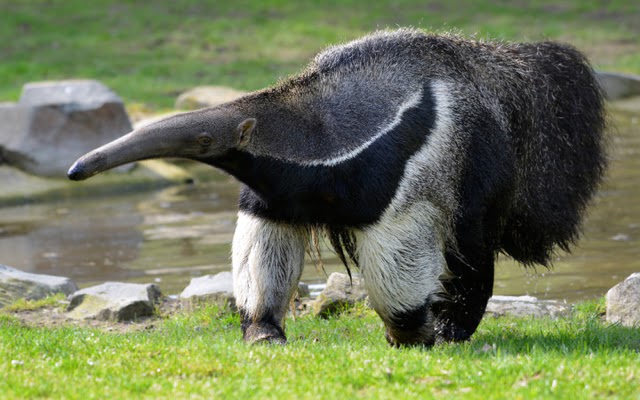
Have you ever wondered what it would be like if your name was based on what you eat the most? What do you think your name would be?
Maybe you would be called a pizzaeater? Or maybe a chickennuggeteater? We bet there are even some peanutbutterandjellyeaters out there.
Anteaters, also known as “antbears,” are a group of four mammal species belonging to the suborder Vermilingua. The four species include the Giant Anteater, the Silky Anteater, the Southern Tamandua, and the Northern Tamandua.
The Giant Anteater, as the name suggests, is the largest among these species. It can grow up to eight feet long, including its tail.
The Northern and Southern Tamanduas, also called “Collared Anteaters,” reach a length of about four feet. The Silky Anteater is the smallest among them, measuring just a little over a foot in length.
The suborder to which anteaters belong, Vermilingua, means “worm tongue.” Since anteaters lack teeth, they rely on their long tongues to scoop up ants and termites, which form the majority of their diet.
An anteater’s tongue can flick up to 160 times per minute, allowing them to consume up to 35,000 ants and termites in a day!
When searching for food, anteaters use their sharp claws to tear open anthills or decaying wood that may contain ants or termites. Due to their poor eyesight, they rely on their sense of smell to locate food.
They then use their long snouts and tongues to capture as many ants and termites as possible. Since they lack teeth, they cannot chew the insects.
Instead, they swallow them whole. While feeding, anteaters also ingest small pebbles and other debris, which aids in the digestion process by grinding the insects in their stomachs.
In addition to ants and termites, anteaters also consume soft-bodied grubs, soft fruits, and bird eggs. Anteaters in zoos are fed fruits, hard-boiled eggs, ground beef, and dog kibble.
If you have encountered ants before, you are probably aware that they can sting. Anteaters are well aware of this, too.
When ants start to defend themselves while an anteater is feeding, the anteater usually moves on to a different location. Rather than destroying an entire ant nest, most anteaters prefer to return to feed again in the future.
Anteaters are primarily found in the tropical forests and grasslands of Central and South America. Giant anteaters typically sleep aboveground, while the other species of anteaters prefer to live in trees.
Giant anteaters move slowly with a distinct shuffle. This is because they walk on their fists, with their claws curled up into their paws, to protect their claws from getting dull on the ground. They are also skilled swimmers and can use their long snouts as snorkels.
Give it a Try
Are you interested in learning more about anteaters? Find a friend or family member to join you in exploring the following activities:
- Interested in learning more about the largest species of anteaters? Visit the San Diego Zoo website’s page on the Giant Anteater. Take note of 2-3 new facts that you discover and share them with a friend or family member.
- While expanding your knowledge on anteaters, why not learn how to say “Anteater” in various languages? How many different translations of “Anteater” can you remember? Do you believe this information could ever come in handy? If so, why?
- So, what are your thoughts on anteaters? Would you consider having one as a pet? Why or why not? Do you find the idea of eating ants and termites repulsive? Does it give you a creepy-crawly sensation in your stomach just thinking about it? If you had to live like an anteater for a day, how would you add some flavor to your diet? What new things would you be willing to try? Can you come up with any delectable ant or termite recipes that you would recommend? How about this enjoyable recipe for chocolate-covered ants?
Sources of Wonder
- http://maiaw.com/anteater/
- http://animals.nationalgeographic.com/animals/mammals/giant-anteater/
- http://www.sandiegozoo.org/animalbytes/t-anteater.html
FAQ
1. Do anteaters eat only ants?
No, anteaters do not eat only ants. While ants are their primary food source, anteaters also consume termites and other insects. Anteaters have long, sticky tongues that they use to catch their prey. They can consume thousands of ants in a single day. However, they also eat termites, which they locate using their keen sense of smell. So, while ants are their preferred food, anteaters do eat other insects as well.
2. What other insects do anteaters eat?
Aside from ants, anteaters also eat termites. Termites are another common food source for anteaters. They use their strong forelimbs to dig into termite mounds and then use their long tongues to lick up the insects. Anteaters are also known to eat other small insects such as beetles and larvae. However, ants and termites make up the majority of their diet.
3. Why do anteaters primarily eat ants?
Anteaters primarily eat ants because ants are abundant and provide a rich source of nutrients. Ants are high in protein and fat, which is essential for the anteater’s survival. Anteaters have adapted to have long snouts and tongues specifically for feeding on ants. Their sticky tongues can reach deep into ant nests to catch the insects. Additionally, ants are easier to catch and consume compared to other insects, making them a convenient food source for anteaters.
4. Can anteaters survive on a diet of only ants?
Yes, anteaters can survive on a diet of only ants. Ants provide all the necessary nutrients, including protein and fat, that anteaters need to survive. Anteaters have evolved to have specialized adaptations for consuming ants, such as their long snouts and sticky tongues. However, while ants are their preferred food, anteaters can also eat termites and other insects if ants are not available. They are opportunistic feeders and will consume whatever insects they can find in their habitat.





Leave a Reply